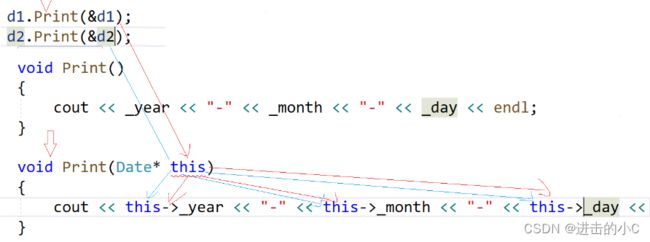C++-类和对象(1)
1.面向过程和面向对象初步认识
C语言是面向过程的,关注的是过程,分析出求解问题的步骤,通过函数调用逐步解决问题。
C++是基于面向对象的,关注的是对象,将一件事情拆分成不同的对象,靠对象之间的交互完
2.类的引入
C语言结构体中只能定义变量,在C++中,结构体内不仅可以定义变量,也可以定义函数。比如: 之前在数据结构中,用C语言方式实现的栈,结构体中只能定义变量;现在以C++方式实现, 会发现struct中也可以定义函数。
typedef int DataType;
struct Stack
{
void Init(size_t capacity)
{
_array = (DataType*)malloc(sizeof(DataType) * capacity);
if (nullptr == _array)
{
perror("malloc申请空间失败");
return;
}
_capacity = capacity;
_size = 0;
}
void Push(const DataType& data)
{
// 扩容
_array[_size] = data;
++_size;
}
DataType Top()
{
return _array[_size - 1];
}
void Destroy()
{
if (_array)
{
free(_array);
_array = nullptr;
_capacity = 0;
_size = 0;
}
}
DataType* _array;
size_t _capacity;
size_t _size;
};3.类的定义
class className
{
// 类体:由成员函数和成员变量组成
}; // 一定要注意后面的分号一般情况下,更期望采用第二种方式。
成员变量命名规则的建议:
// 我们看看这个函数,是不是很僵硬?
class Date
{
public:
void Init(int year)
{
// 这里的year到底是成员变量,还是函数形参?
year = year;
}
private:
int year;
};
// 所以一般都建议这样
class Date
{
public:
void Init(int year)
{
_year = year;
}
private:
int _year;
};
// 或者这样
class Date
{
public:
void Init(int year)
{
mYear = year;
}
private:
int mYear;
};4.类的访问限定符及封装
4.1 访问限定符
C++实现封装的方式:用类将对象的属性与方法结合在一块,让对象更加完善,通过访问权限选 择性的将其接口提供给外部的用户使用。
【访问限定符说明】
1. public修饰的成员在类外可以直接被访问
2. protected和private修饰的成员在类外不能直接被访问(此处protected和private是类似的)
3. 访问权限作用域从该访问限定符出现的位置开始直到下一个访问限定符出现时为止
4. 如果后面没有访问限定符,作用域就到 } 即类结束。
注意:访问限定符只在编译时有用,当数据映射到内存后,没有任何访问限定符上的区别
问题:C++中struct和class的区别是什么?
解答:C++需要兼容C语言,所以C++中struct可以当成结构体使用。另外C++中struct还可以用来定义类。和class定义类是一样的,区别是struct定义的类默认访问权限是public,class定义的类 默认访问权限是private。注意:在继承和模板参数列表位置,struct和class也有区别,后序给大 家介绍。
4.2 封装
面向对象的三大特性:封装、继承、多态。
5.类的作用域
类定义了一个新的作用域,类的所有成员都在类的作用域中。在类体外定义成员时,需要使用 :: 作用域操作符指明成员属于哪个类域。
假设我们在Person里面声明了一个PrintPersonInfo函数,那么在类的外部进行定义的时候就需要指定PrintPersonInfo是属于Person这个类域。
class Person
{
public:
void PrintPersonInfo();
private:
char _name[20];
char _gender[3];
int _age;
};
// 这里需要指定PrintPersonInfo是属于Person这个类域
void Person::PrintPersonInfo()
{
cout << _name << " " << _gender << " " << _age << endl;
}6.类的实例化
1. 类是对对象进行描述的 ,是一个 模型 一样的东西,限定了类有哪些成员,定义出一个类 并没 有分配实际的内存空间 来存储它;比如:入学时填写的学生信息表,表格就可以看成是一个 类,来描述具体学生信息。类就像谜语一样,对谜底来进行描述,谜底就是谜语的一个实例。谜语: " 年纪不大,胡子一把,主人来了,就喊妈妈 " 谜底:山羊2. 一个类可以实例化出多个对象, 实例化出的对象 占用实际的物理空间,存储类成员变量
int main()
{
Person._age = 100; // 编译失败:error C2059: 语法错误:“.”
return 0;
}Person类是没有空间的,只有Person类实例化出的对象才有具体的年龄。
7.类对象模型
7.1 如何计算类对象的大小
class A
{
public:
void PrintA()
{
cout << _a << endl;
}
private:
char _a;
};7.2 结构体内存对齐规则
1. 第一个成员在与结构体偏移量为 0 的地址处。2. 其他成员变量要对齐到某个数字(对齐数)的整数倍的地址处。注意:对齐数 = 编译器默认的一个对齐数 与 该成员大小的较小值。VS 中默认的对齐数为 83. 结构体总大小为:最大对齐数(所有变量类型最大者与默认对齐参数取最小)的整数倍。4. 如果嵌套了结构体的情况,嵌套的结构体对齐到自己的最大对齐数的整数倍处,结构体的整 体大小就是所有最大对齐数(含嵌套结构体的对齐数)的整数倍。
8.this指针
8.1 this指针的引出
我们先来定义一个日期类 Date :
class Date
{
public:
void Init(int year, int month, int day)
{
_year = year;
_month = month;
_day = day;
}
void Print()
{
cout << _year << "-" << _month << "-" << _day << endl;
}
private:
int _year;
int _month;
int _day;
};
int main()
{
Date d1, d2;
d1.Init(2023, 12, 26);
d2.Init(2023, 12, 27);
d1.Print();
d2.Print();
return 0;
}8.2 this指针的特性
1. this 指针的类型:类类型 * const ,即成员函数中,不能给 this 指针赋值。2. 只能在 “ 成员函数 ” 的内部使用3. this 指针本质上是 “ 成员函数 ” 的形参 ,当对象调用成员函数时,将对象地址作为实参传递给 this形参。所以 对象中不存储 this 指针 。4. this 指针是 “ 成员函数 ” 第一个隐含的指针形参,一般情况由编译器通过 ecx 寄存器自动传递,不需要用户传递.
思考:
this指针存在哪里?
this指针是个形参,所以是存在栈帧上面的。
下面这段代码可以正常运行,为什么呢?
因为成员函数的地址不存放在对象里面,成员变量的地址才存放在对象里面,
// 1.下面程序编译运行结果是? A、编译报错 B、运行崩溃 C、正常运行
class A
{
public:
void Print()
{
cout << "Print()" << endl;
}
private:
int _a;
};
int main()
{
A* p = nullptr;
p->Print();
return 0;
}这里访问_a就会崩溃,因为_a实质上是this->_a,而this是空指针。
// 1.下面程序编译运行结果是? A、编译报错 B、运行崩溃 C、正常运行
class A
{
public:
void PrintA()
{
cout << _a << endl;
}
private:
int _a;
};
int main()
{
A* p = nullptr;
p->PrintA();
return 0;
}8.3. C语言和C++实现Stack的对比
1. C语言实现
typedef int DataType;
typedef struct Stack
{
DataType* array;
int capacity;
int size;
}Stack;
void StackInit(Stack* ps)
{
assert(ps);
ps->array = (DataType*)malloc(sizeof(DataType) * 3);
if (NULL == ps->array)
{
assert(0);
return;
}
ps->capacity = 3;
ps->size = 0;
}
void StackDestroy(Stack* ps)
{
assert(ps);
if (ps->array)
{
free(ps->array);
ps->array = NULL;
ps->capacity = 0;
ps->size = 0;
}
}
void CheckCapacity(Stack* ps)
{
if (ps->size == ps->capacity)
{
int newcapacity = ps->capacity * 2;
DataType* temp = (DataType*)realloc(ps->array,
newcapacity * sizeof(DataType));
if (temp == NULL)
{
perror("realloc申请空间失败!!!");
return;
}
ps->array = temp;
ps->capacity = newcapacity;
}
}
void StackPush(Stack* ps, DataType data)
{
assert(ps);
CheckCapacity(ps);
ps->array[ps->size] = data;
ps->size++;
}
int StackEmpty(Stack* ps)
{
assert(ps);
return 0 == ps->size;
}
void StackPop(Stack* ps)
{
if (StackEmpty(ps))
return;
ps->size--;
}
DataType StackTop(Stack* ps)
{
assert(!StackEmpty(ps));
return ps->array[ps->size - 1];
}
int StackSize(Stack* ps)
{
assert(ps);
return ps->size;
}
int main()
{
Stack s;
StackInit(&s);
StackPush(&s, 1);
StackPush(&s, 2);
StackPush(&s, 3);
StackPush(&s, 4);
printf("%d\n", StackTop(&s));
printf("%d\n", StackSize(&s));
StackPop(&s);
StackPop(&s);
printf("%d\n", StackTop(&s));
printf("%d\n", StackSize(&s));
StackDestroy(&s);
return 0;
}2. C++实现
typedef int DataType;
class Stack
{
public:
void Init()
{
_array = (DataType*)malloc(sizeof(DataType) * 3);
if (NULL == _array)
{
perror("malloc申请空间失败!!!");
return;
}
_capacity = 3;
_size = 0;
}
void Push(DataType data)
{
CheckCapacity();
_array[_size] = data;
_size++;
}
void Pop()
{
if (Empty())
return;
_size--;
}
DataType Top() { return _array[_size - 1]; }
int Empty() { return 0 == _size; }
int Size() { return _size; }
void Destroy()
{
if (_array)
{
free(_array);
_array = NULL;
_capacity = 0;
_size = 0;
}
}
private:
void CheckCapacity()
{
if (_size == _capacity)
{
int newcapacity = _capacity * 2;
DataType* temp = (DataType*)realloc(_array, newcapacity *
sizeof(DataType));
if (temp == NULL)
{
perror("realloc申请空间失败!!!");
return;
}
_array = temp;
_capacity = newcapacity;
}
}
private:
DataType* _array;
int _capacity;
int _size;
};
int main()
{
Stack s;
s.Init();
s.Push(1);
s.Push(2);
s.Push(3);
s.Push(4);
printf("%d\n", s.Top());
printf("%d\n", s.Size());
s.Pop();
s.Pop();
printf("%d\n", s.Top());
printf("%d\n", s.Size());
s.Destroy();
return 0;
}今天的分享到这里就结束,感谢大家的阅读!


